QuestionOkay my 10 yr. old son has had his leopard lizard since Christmas. We took him into a pet store with us to ask some questions(un-related to this question)and they told us that he was one of the healthiest ones they had ever seen....He seems very active and is given attention often but last night my son noticed that his tail looks as though it has a cut or some kind of a slice on it. I checked it out and it looks like it might wanna fall off. Its just on the beginning of his tip of his tail. My question is should I be worried or take him to a vet? Or is this something normal?
AnswerHi Theresa,
I"ve included a basic care sheet so you can double check your care info from the pet store. I do want to say that I wouldn't take the word of a pet store as to the health of your leo. Pet stores(most) have no idea of the proper care the critters they sell need.
Its not normal for a leo to have a cut on its tail...but it does happen. They have the ability to drop their tails(generally its up much higher than what you are describing) when the tail is grabbed.
It should just fall off, but it may heal up. You can apply some neosporin ointment to it. Normal would be for the area below the cut to dry up and fall off...In the drying up, it will look black..if you see the drying happening to the body side of the cut,(other than a small scab) then a vet is needed asap as that would be a sign of gangrene invading the healthy part of the tail.If it begins to look sore, oozing or any other change, then a vet should be consulted as those are signs of infection. There are links to finding a vet that can care for reptiles below. If you are using sand or other loose substrate please remove it so as that it does not get into the wound. Also, please read the information in the care sheet about sand and other loose substrates.
Check out his cage to make sure there is nothing that he may have caught the tail on/in such as between rocks, a wire from a fake plant, etc.
Their tails are their fat storage. When their tail is gone, they loose their fat storage which can be a problem until it heals over and begins to grow back sometimes. With it just being the tip, it may or may not grow back, but with the leo being young there is more chance for it to grow back, although generally won't look as nice as the original.
BASIC CARE FOR A LEOPARD GECKO
Leopards are pretty easy to care for but they do need
special care. Here are some of the basic needs of your gecko.
HOUSING: The need to have at least a 20 gallon long tank for one Leo. This needs to have a secure fitting screen top...they can be quite the escape artists!!! They need to have a humid hide box.You can make this with something as simple as a small plastic dish with a hole cut in one side and a small mesh bag filled with some Sphagnum moss coconut bark or Peat moss that you mist.
I made mine out of the small plastic folgers coffee containers...I cut an opening in the lid..and put the moss in..they LOVE it. I use the terrarium moss in mine.
I use that on the warm side of the tank. Be sure to provide a cool hidebox on the other end. I also provide a mid temperature hide...which is in the middle of the tank.I use the critter caves which you can purchase. NOT the ones that have heat in them!!!!
Provide secure climbing areas for your gecko. Fake plants, rocks and branches are all fine to use. be sure there are no wires or sharp ends to any fake plants you use.
*****SUBSTRATE:(that's the stuff on the floor of your tank) Newspaper, lizard carpet or paper towels work great and are easy to clean and are much safer than any loose substrate. Sand or other loose substrate is not recommended as that they can be deadly to the leo when it is ingested(eaten, even by accident while eating their insects)...A very graphic site of an impacted leo surg can be seen at http://homepage.mac.com/exoticdvm/reptile/PhotoAlbum181.html it is very graphic!!! ******What I have found that works great for safety and heat distribution is using about 1/4 inch of childrens play sand(since the tiles fit tight together, there is no sand danger) on the bottom of the tank and on top that you place ceramic or slate floor tile. What is nice is that the 12 x 12 squares fit perfect in a 20 gallon tank with no spaces between the tiles. The sand and the tile distribute the heat wonderfully. Using the under tank heater as described is what distributes the heat. Also, overhead heat will help in heating the tiles...I've been using this set up for several years and the leos love it. Using a tile that isn't smooth is recommended. **********
TEMPERATURES: They need a warm area of 88-92 degrees and a
cooler area in the upper 70s, low 80s. At night their temperature can drop to the low to mid 70's.
Never use a hot rock for a leopard gecko...or any reptile.
They can severely burn any reptile. You can use a heating
pad under the tank,under tank heater, or you can use a regular household lightbulb in a dome fixture with a ceramic socket in it to keep the warm area at the 88-90 degree area.At night, no white light. If room temperatures stay above 70 degrees, no extra night heat is needed. The undertank heater or heating pad should cover about 1/3 of the tank....be sure to raise the tank up about 1/4-1/2 inch off the stand when using an undertank heat source to prevent heat build up which can cause the glass to break and hot spots in the glass. Be sure to have a good layer of newspaper, carpeting or, even a thin flat rock(such as tile) on top the area that the undertank heat source is placed...if you use a thin rock or tile, it helps to distribute the heat very well.
You can use the special nighttime lights that are designed for reptiles. I like using a ceramic heat emitter on a thermostat for nighttime heat.
DO NOT use black lights or party lights as they can cause eye damage!!!!
The wattage you use will vary based on room temperature and size of tank.
LIGHTING: Leopard geckos do not need UVB lighting but it does not hurt them to give them uvb. They should have some type of light during the day, be it a uvb tube, regular florescent light, reptile day light or regular household lightbulb. NO white lights at night!!!
FEEDING: Geckos should not be fed crickets or other insects that are bigger than the space between their eyes. Generally, hatchlings can be fed more than once a day,juvys can be fed twice a day, adults are fed once daily or every other day, in the early evening. Crickets and other food items such as silk worms, super, and an occasional treat of a wax worm, need to be dusted with a calcium supplement two times a week and also they should have a small dish of calcium in their tank. I use the lid of a milk jug for the little dish of calcium in their tank. For dusting the insects, Use a calcium with no added phosphorus. Insects must be gut loaded(fed) for at least 48 hours prior to feeding your gecko. Remove any uneaten crix or superworms after 15-20 minutes..... Place a piece of cut potato in the tank so that if you have missed any uneaten insects, they will eat the potato instead of nibbling on your gecko!!!
*************You have to be sure to feed your crickets and insects the right foods before feeding them to your gecko. If your crickets/insects are not healthy and well fed, your gecko will not get the nutrition he needs. You can gut load your crickets and insects greens, veggies, cereals or specially designed commercial foods for crickets or the insects you are feeding. ************
Be sure to have a small dish of clean water for your gecko at all times!!
You can offer them some baby food or fruits on occasion ...
Mine will even eat a small piece of watermelon now and then.WATER: always provide a dish of drinking water. If you choose to mist your gecko to drink, its best to not get the tank too wet as that they do not do well with higher humidity. Sometimes its better to take your leo out of their tank to mist them to get them to drink!!!
HANDLING: Some geckos enjoy being held...others prefer not to be handled at all. Be sure to be very gentle when holding your leo and NEVER grab them by the tail! Their tails are extremely fragile and will break.
I do suggest finding a vet that can treat reptiles BEFORE you actually need one!!! To find a vet that is able to care for reptiles:
http://www.anapsid.org/vets
http://www.arav.org/Directory.htm
For more information on leopard geckos:
http://www.thegeckospot.com/leocareindex2.html
http://www.drgecko.com
If you have any questions or don't understand something, please let me know.

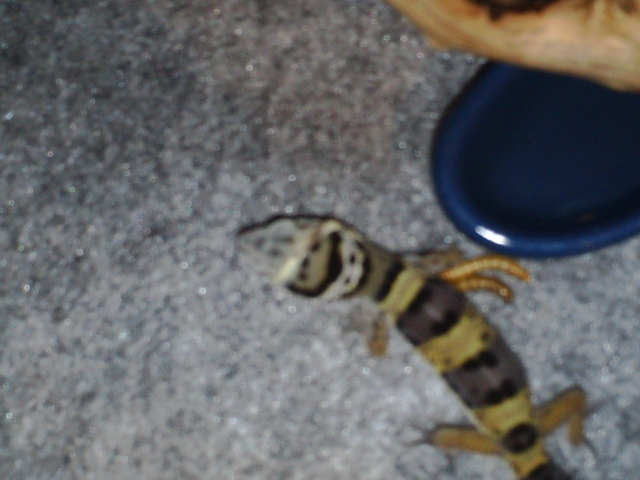 Temperature
QuestionStuck skin on geckos h
QUESTION: My leop
Temperature
QuestionStuck skin on geckos h
QUESTION: My leop
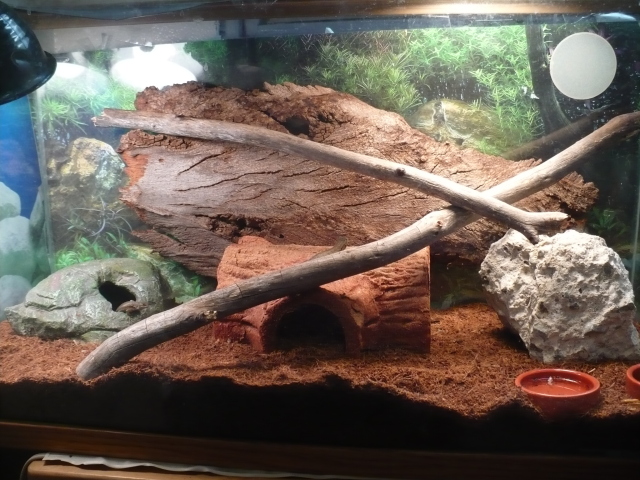 blue belly lizard - watery and smelly feces
Questionlews bellies 2 023
QUESTION: Hello, and
blue belly lizard - watery and smelly feces
Questionlews bellies 2 023
QUESTION: Hello, and
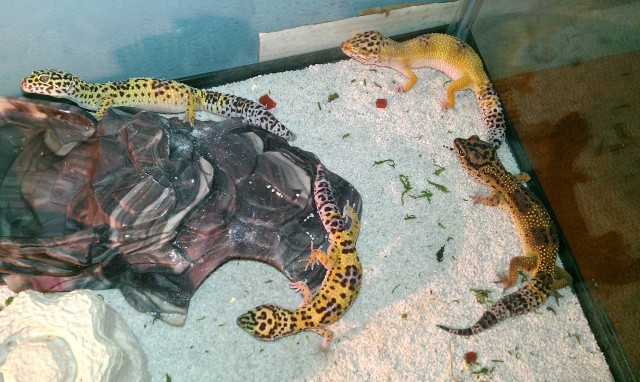 My Leopard Gecko doesnt seem to be eating
Question
My Geckos
First off, I would personally
My Leopard Gecko doesnt seem to be eating
Question
My Geckos
First off, I would personally
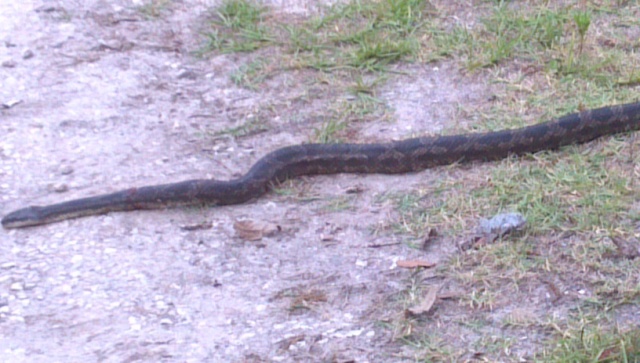 snake curled up in my back tire
Question
pic 1
Hello, I would like to know what
snake curled up in my back tire
Question
pic 1
Hello, I would like to know what
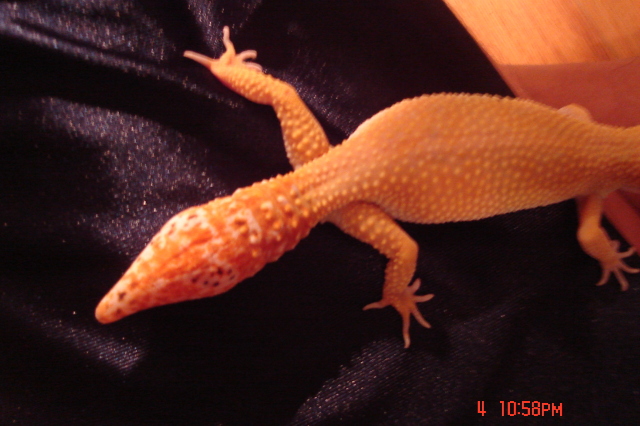 dystocia or not
Questiontail
QUESTION: Hi Diane. How are you tod
dystocia or not
Questiontail
QUESTION: Hi Diane. How are you tod